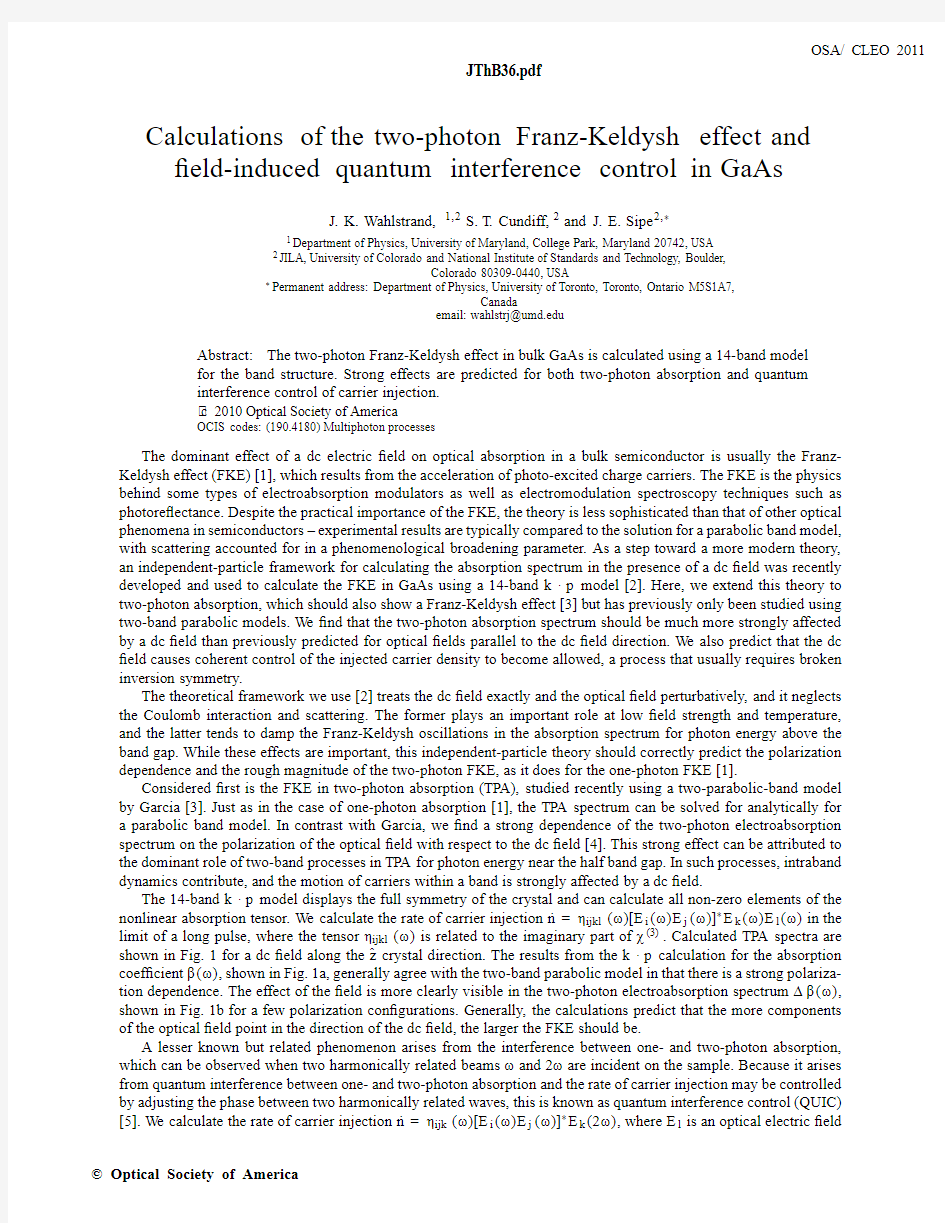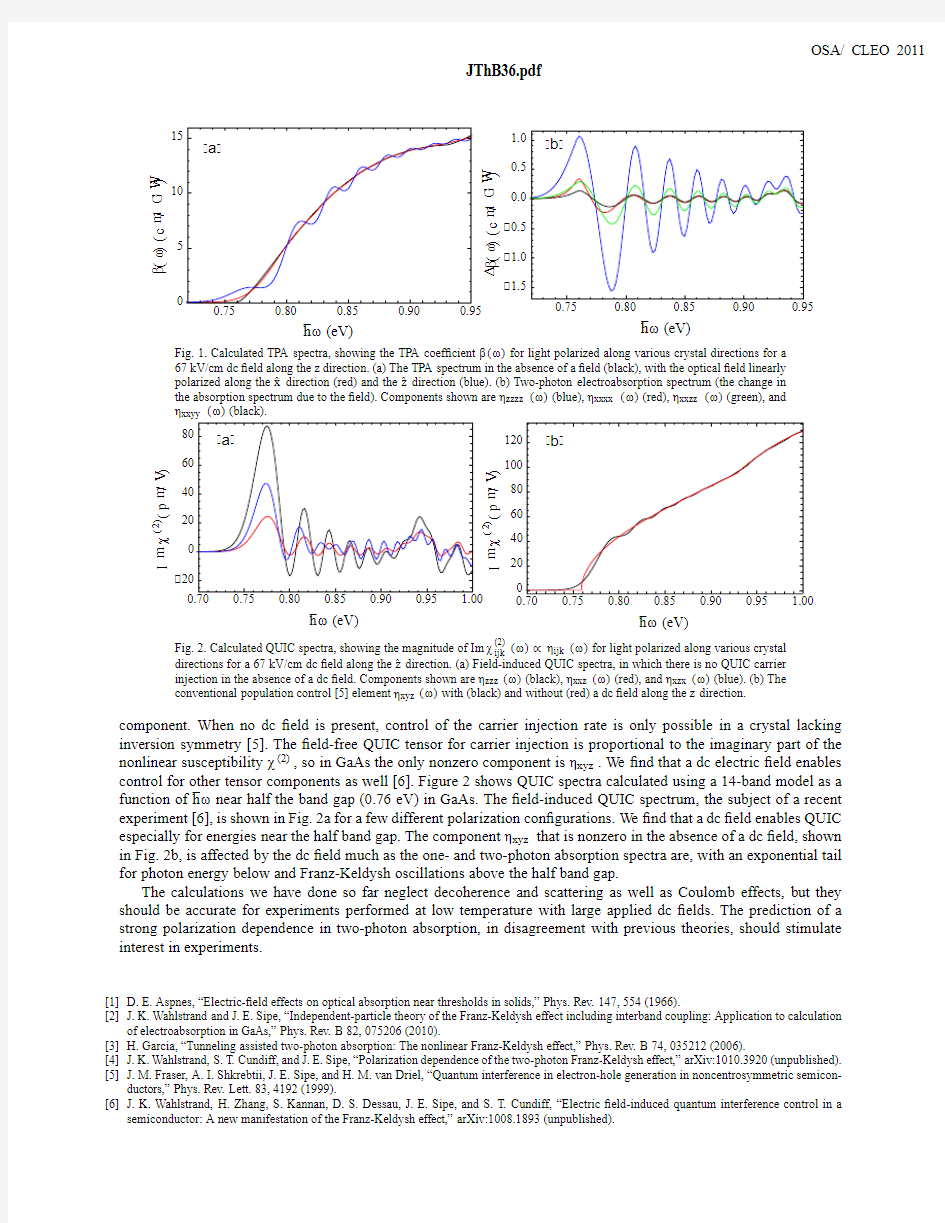Calculations of the two-photon Franz-Keldysh effect and field-induced interference control in GaAs


Calculations of the two-photon Franz-Keldysh effect and
?eld-induced quantum interference control in GaAs
J.K.Wahlstrand,1,2S.T.Cundiff,2and J.E.Sipe2,?
1Department of Physics,University of Maryland,College Park,Maryland20742,USA
2JILA,University of Colorado and National Institute of Standards and Technology,Boulder,
Colorado80309-0440,USA
?Permanent address:Department of Physics,University of Toronto,Toronto,Ontario M5S1A7,
Canada
email:wahlstrj@https://www.360docs.net/doc/2b7647277.html,
Abstract:The two-photon Franz-Keldysh effect in bulk GaAs is calculated using a14-band model
for the band structure.Strong effects are predicted for both two-photon absorption and quantum
interference control of carrier injection.
c 2010Optical Society of America
OCIS codes:(190.4180)Multiphoton processes
The dominant effect of a dc electric?eld on optical absorption in a bulk semiconductor is usually the Franz-Keldysh effect(FKE)[1],which results from the acceleration of photo-excited charge carriers.The FKE is the physics behind some types of electroabsorption modulators as well as electromodulation spectroscopy techniques such as photore?ectance.Despite the practical importance of the FKE,the theory is less sophisticated than that of other optical phenomena in semiconductors–experimental results are typically compared to the solution for a parabolic band model, with scattering accounted for in a phenomenological broadening parameter.As a step toward a more modern theory, an independent-particle framework for calculating the absorption spectrum in the presence of a dc?eld was recently developed and used to calculate the FKE in GaAs using a14-band k·p model[2].Here,we extend this theory to two-photon absorption,which should also show a Franz-Keldysh effect[3]but has previously only been studied using two-band parabolic models.We?nd that the two-photon absorption spectrum should be much more strongly affected by a dc?eld than previously predicted for optical?elds parallel to the dc?eld direction.We also predict that the dc ?eld causes coherent control of the injected carrier density to become allowed,a process that usually requires broken inversion symmetry.
The theoretical framework we use[2]treats the dc?eld exactly and the optical?eld perturbatively,and it neglects the Coulomb interaction and scattering.The former plays an important role at low?eld strength and temperature, and the latter tends to damp the Franz-Keldysh oscillations in the absorption spectrum for photon energy above the band gap.While these effects are important,this independent-particle theory should correctly predict the polarization dependence and the rough magnitude of the two-photon FKE,as it does for the one-photon FKE[1].
Considered?rst is the FKE in two-photon absorption(TPA),studied recently using a two-parabolic-band model by Garcia[3].Just as in the case of one-photon absorption[1],the TPA spectrum can be solved for analytically for
a parabolic band model.In contrast with Garcia,we?nd a strong dependence of the two-photon electroabsorption
spectrum on the polarization of the optical?eld with respect to the dc?eld[4].This strong effect can be attributed to the dominant role of two-band processes in TPA for photon energy near the half band gap.In such processes,intraband dynamics contribute,and the motion of carriers within a band is strongly affected by a dc?eld.
The14-band k·p model displays the full symmetry of the crystal and can calculate all non-zero elements of the nonlinear absorption tensor.We calculate the rate of carrier injection˙n=ηijkl(ω)[E i(ω)E j(ω)]?E k(ω)E l(ω)in the limit of a long pulse,where the tensorηijkl(ω)is related to the imaginary part ofχ(3).Calculated TPA spectra are shown in Fig.1for a dc?eld along the?z crystal direction.The results from the k·p calculation for the absorption coef?cientβ(ω),shown in Fig.1a,generally agree with the two-band parabolic model in that there is a strong polariza-tion dependence.The effect of the?eld is more clearly visible in the two-photon electroabsorption spectrum?β(ω), shown in Fig.1b for a few polarization con?gurations.Generally,the calculations predict that the more components of the optical?eld point in the direction of the dc?eld,the larger the FKE should be.
A lesser known but related phenomenon arises from the interference between one-and two-photon absorption,
which can be observed when two harmonically related beamsωand2ωare incident on the sample.Because it arises from quantum interference between one-and two-photon absorption and the rate of carrier injection may be controlled by adjusting the phase between two harmonically related waves,this is known as quantum interference control(QUIC)
[5].We calculate the rate of carrier injection˙n=ηijk(ω)[E i(ω)E j(ω)]?E k(2ω),where E l is an optical electric?eld ? Optical Society of America
a
0.750.800.850.900.9505
1015 b 0.750.800.850.900.95
1.5 1.0
0.5
0.00.51.0ˉ
h ω(eV)ˉh ω(eV)β(ω)(c m /G W )?β(ω)(c m /G W )Fig.1.Calculated TPA spectra,showing the TPA coef?cient β(ω)for light polarized along various crystal directions for a
67kV/cm dc ?eld along the z direction.(a)The TPA spectrum in the absence of a ?eld (black),with the optical ?eld linearly
polarized along the ?x
direction (red)and the ?z direction (blue).(b)Two-photon electroabsorption spectrum (the change in the absorption spectrum due to the ?eld).Components shown are ηzzzz (ω)(blue),ηxxxx (ω)(red),ηxxzz (ω)(green),and ηxxyy (ω)(black).
a
0.700.750.800.850.900.95 1.00 20020406080 b 0.70
0.750.800.850.900.95 1.000
20
406080100120ˉh ω(eV)ˉh ω(eV)I m χ(2)(p m /V )I m χ(2)(p m /V )Fig.2.Calculated QUIC spectra,showing the magnitude of Im χ(2)ijk (ω)∝ηijk (ω)for light polarized along various crystal
directions for a 67kV/cm dc ?eld along the ?z
direction.(a)Field-induced QUIC spectra,in which there is no QUIC carrier injection in the absence of a dc ?https://www.360docs.net/doc/2b7647277.html,ponents shown are ηzzz (ω)(black),ηxxz (ω)(red),and ηxzx (ω)(blue).(b)The
conventional population control [5]element ηxyz (ω)with (black)and without (red)a dc ?eld along the z direction.
component.When no dc ?eld is present,control of the carrier injection rate is only possible in a crystal lacking inversion symmetry [5].The ?eld-free QUIC tensor for carrier injection is proportional to the imaginary part of the nonlinear susceptibility χ(2),so in GaAs the only nonzero component is ηxyz .We ?nd that a dc electric ?eld enables control for other tensor components as well [6].Figure 2shows QUIC spectra calculated using a 14-band model as a function of ˉh ωnear half the band gap (0.76eV)in GaAs.The ?eld-induced QUIC spectrum,the subject of a recent experiment [6],is shown in Fig.2a for a
few different polarization con?gurations.We ?nd that a dc ?eld enables QUIC especially for energies near the half band gap.The component ηxyz that is nonzero in the absence of a dc ?eld,shown in Fig.2b,is affected by the dc ?eld much as the one-and two-photon absorption spectra are,with an exponential tail for photon energy below and Franz-Keldysh oscillations above the half band gap.
The calculations we have done so far neglect decoherence and scattering as well as Coulomb effects,but they should be accurate for experiments performed at low temperature with large applied dc ?elds.The prediction of a strong polarization dependence in two-photon absorption,in disagreement with previous theories,should stimulate interest in experiments.
[1] D.E.Aspnes,“Electric-?eld effects on optical absorption near thresholds in solids,”Phys.Rev.147,554(1966).
[2]J.K.Wahlstrand and J.E.Sipe,“Independent-particle theory of the Franz-Keldysh effect including interband coupling:Application to calculation
of electroabsorption in GaAs,”Phys.Rev.B 82,075206(2010).
[3]H.Garcia,“Tunneling assisted two-photon absorption:The nonlinear Franz-Keldysh effect,”Phys.Rev.B 74,035212(2006).
[4]J.K.Wahlstrand,S.T.Cundiff,and J.E.Sipe,“Polarization dependence of the two-photon Franz-Keldysh effect,”arXiv:1010.3920(unpublished).
[5]J.M.Fraser,A.I.Shkrebtii,J.E.Sipe,and H.M.van Driel,“Quantum interference in electron-hole generation in noncentrosymmetric semicon-
ductors,”Phys.Rev.Lett.83,4192(1999).
[6]J.K.Wahlstrand,H.Zhang,S.Kannan,D.S.Dessau,J.E.Sipe,and S.T.Cundiff,“Electric ?eld-induced quantum interference control in a
semiconductor:A new manifestation of the Franz-Keldysh effect,”arXiv:1008.1893(unpublished).
